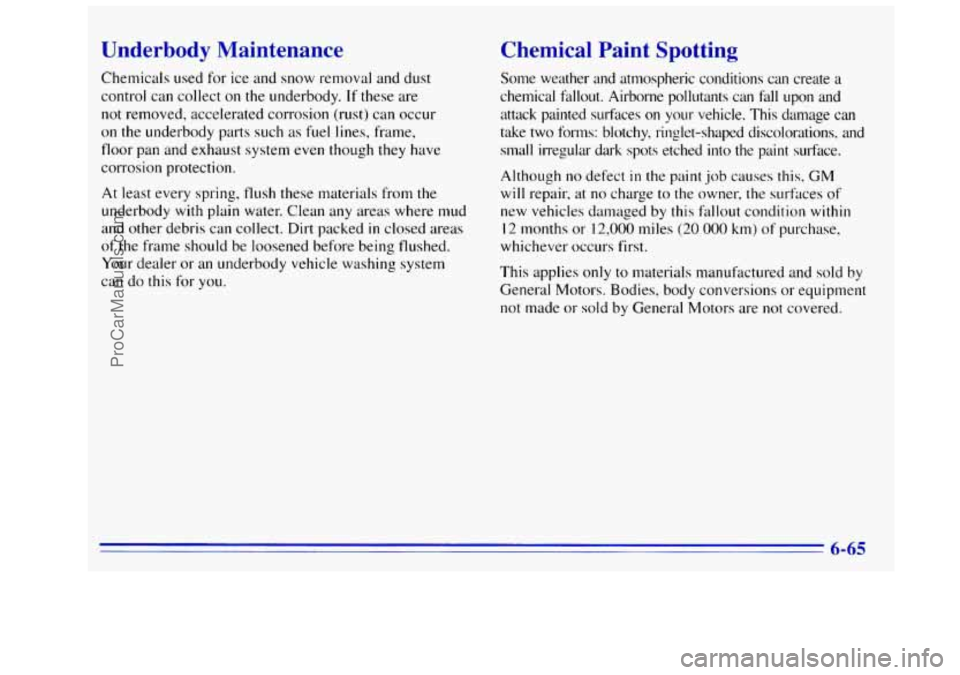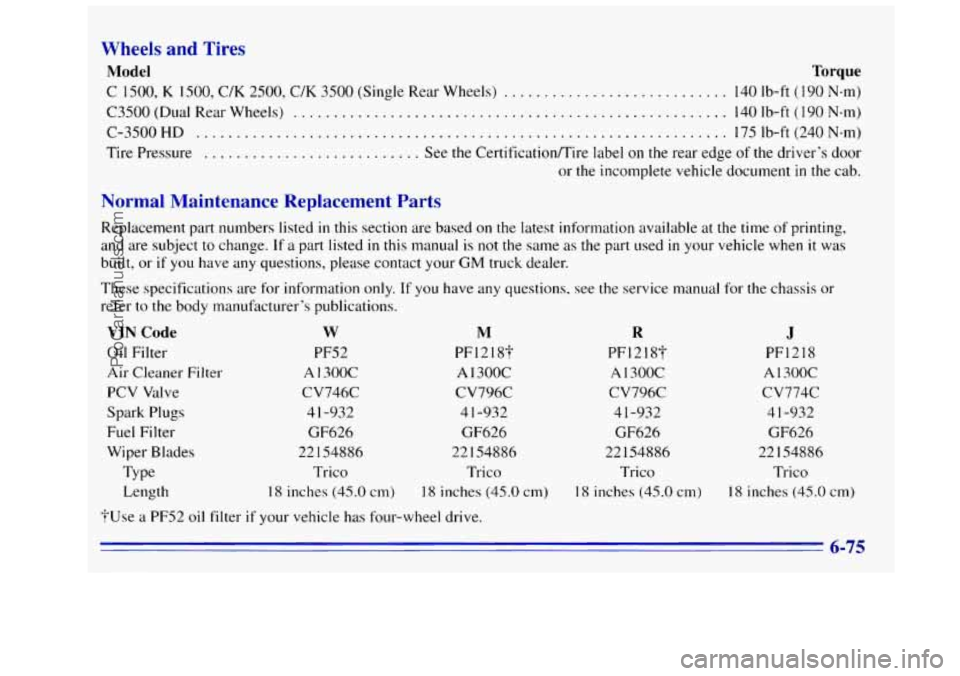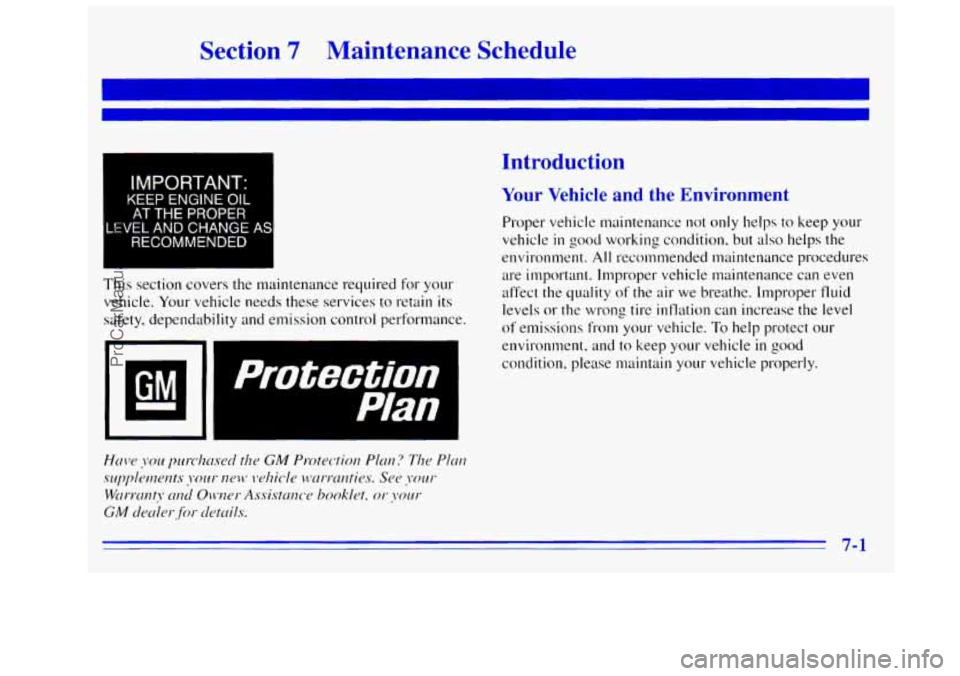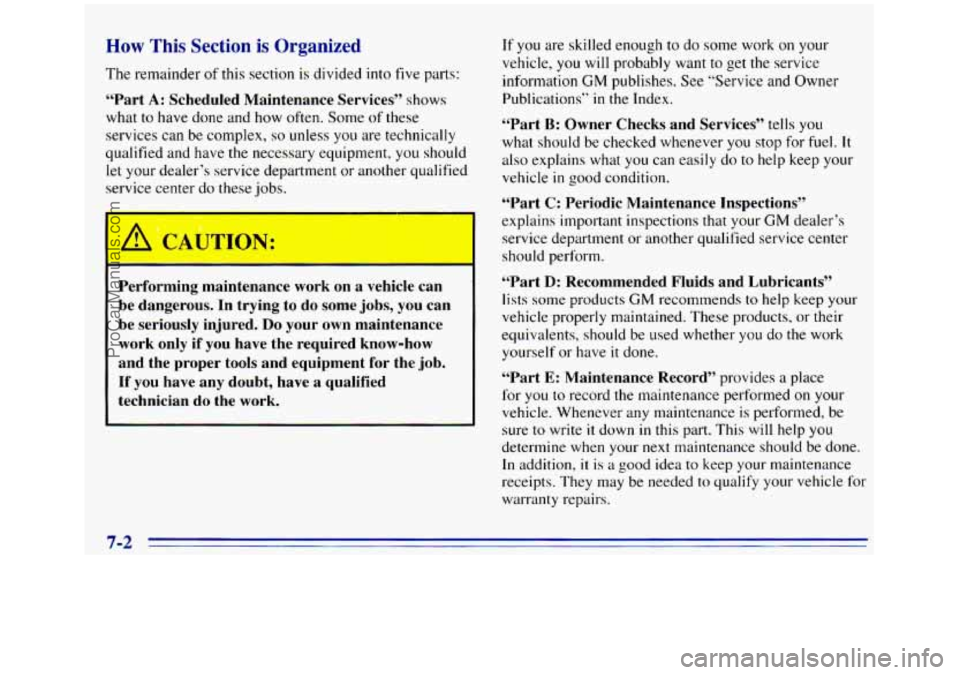1996 GMC SIERRA maintenance
[x] Cancel search: maintenancePage 283 of 404

Brakes
Brake Fluid
Your brake master cylinder
reservoir
is here. It is filled
I with DOT-3 brake fluid.
There are
only two reasons why the brake fluid level in the
reservoir might go down. The first is that
the brake fluid
goes down to an acceptable level during normal brake lining wear. When new linings are put
in, the fluid level
goes back
up. The other reason is that fluid is leaking out
of the brake system. If it is, you should have your brake
system fixed, since a leak
means that sooner or later your
brakes
won’t work well, or won’t work at all.
So, it isn’t a good idea to “top off’ your brake fluid.
Adding
brake fluid won’t correct a leak. If you add fluid
when your linings are worn, then you’ll have
too much
fluid
when you get new brake linings. You should add
(or remove) brake fluid,
as necessary, only when work is
done on the brake hydraulic system.
A CAUTION0
If you have too much brake fluid, it can spill
on the engine. The fluid will burn if the engine
is hot enough. You or others could be burned,
and your vehicle could be damaged. Add brake
fluid only when work
is done on the brake
hydraulic system.
Refer to the Maintenance Schedule to determine when to
check your brake fluid. See “Periodic Maintenance
Inspections”
in the Index.
6-33
ProCarManuals.com
Page 297 of 404

4. Push in gently on
the bulb, turn it
counterclockwise
c
. ..
and remove it from
the socket .
5. Put in a new bulb and, pushing in gently, turn it
clockwise
until it is tight.
6. Put the socket back in the latnp assembly and replace
the lens and lens seal.
indshield Wiper Blade l.Lpldcement
For proper type and length, see "Normal Maintenance
Replacement Parts"
in the Index. To replace the
windshield wiper blade assembly:
1
1. Lift the wiper arm and rotate the blade until it is
facing away
from the windshield.
2. Push the release lever and slide the wipcr asselnbly
toward the driver's side
of the vehicle.
3. Install a new blade by reversing Steps I and 2.
ProCarManuals.com
Page 300 of 404

How to Check
Use a good quality pocket-type gage to check tire
pressure.
You can’t tell if your tires are properly inflated
simply by looking at them. Radial tires may
look
properly inflated even when they’re underinflated.
Be sure
to put the valve caps back on the valve
stems. They help prevent leaks
by keeping out dirt
.and moisture.
Tire Inspection and Rotation
Tires should be inspected every 6,000 to 8,000 miles
(10 000 to 13 000 km) for any signs of unusual wear. If
unusual wear
is present, rotate your tires as soon as
possible and check wheel alignment. Also check for
damaged tires or wheels. See “When It’s Time for New
Tires” and ‘‘Wheel Replacement” later
in this section for
more information.
If your vehicle has dual rear wheels,
also see “Dual ‘Tire Operation” later
in this section.
I
FRT FRT
I
The purpose of regular rotation is to achieve more
uniform wear for all tires on the vehicle. The first
rotation
is the most important. See “Scheduled
Maintenance Services”
in the Index for scheduled
rotation intervals.
If
your vehicle has single rear wheels, always use one of
the correct rotation patterns
shown here when rotating
your tires.
If your vehicle has front [Ires with different load ranges
or tread designs (such as all season vs. on/off road) than
the rear tires, don’t rotate your tires front to rear.
6-50
ProCarManuals.com
Page 315 of 404

Underbody Maintenance
Chemicals used for ice and snow removal and dust
control can collect
on the underbody, If these are
not removed, accelerated corrosion (rust) can occur
on the underbody parts such as fuel lines, frame,
floor pan and exhaust system even though they have
corrosion protection.
At least every spring, flush these materials from the
underbody with plain water. Clean any areas where mud
and other debris can collect. Dirt packed
in closed areas
of the frame should be loosened before being flushed.
Your dealer or an underbody vehicle washing system
can do this for you.
Chemical Paint Spotting
Some weather and atmospheric conditions can create a
chemical fallout. Airborne pollutants can
fdl upon and
attack painted surfxes
on your vehicle. This damage can
take two forms: blotchy, ringlet-shaped discolorations, and
small irregular dark spots etched into the paint surface.
Although
no defect in the paint job causes this, GM
will repair, at no charge to the owner, the surfaces of
new vehicles damaged by this fallout condition within
12 months or 12,000 miles (20 000 km) of purchase,
whichever occurs first.
This applies
only to materials manufactured and sold by
General Motors. Bodies, body conversions or equipment
not made or
sold by General Motors are not covered.
6-65
ProCarManuals.com
Page 325 of 404

Wheels and Tires
Model Torque
C 1500, K 1500, C/K 2500, C/K 3500 (Single Rear Wheels) ............................ 140 Ib-ft (190 N-m)
C3500 (Dual
Rear Wheels) ...................................................... 140 Ib-ft (190 N-m)
Tire Pressure ........................... See the Certificationflire label on the rear edge of the driver's door
or the incomplete vehicle document in the cab.
C-3500HD
.................................................................. 175Ib-ft(240N-m)
Normal Maintenance Replacement Parts
Replacement part numbers listed in this section
are based on the latest information available at the time of printing,
and are subject to change.
If a part listed in this manual is not the same as the part used in your vehicle when it was
built, or
if you have any questions, please contact your GM truck dealer.
These specifications are
for information only. If you have any questions. see the service manual for the chassis or
refer
to the body manufacturer's publications.
VIN Code w M
Oil Filter PF52
PF1218T
Air
Cleaner Filter A 1300C A 1300C
PCV Valve CV746C CV796C
Spark Plugs 4 1-932 4 1-932
Fuel Filter GF626
GF626
Wiper Blades 22 154886 221 54886
Type Trico Trico
Length
18 inches (45.0 cm) 18 inches (45.0 cm)
?Use a PF52 oil filter if your vehicle has four-wheel drive.
R
PF1218T
A 130OC
CV796C
4 1-932
GF626
22 154886
Trico
18 inches (45.0 cm)
J
PF1218
A
1300C
cv774c
41 -932
GF626
22 154886
Trico
18 inches (45.0 cm)
6-75
ProCarManuals.com
Page 327 of 404

Section 7 Maintenance Schedule
I IMPORTANT: I
KEEP ENGINE OIL
AT THE PROPER
LEVEL AND CHANGE AS
RECOMMENDED
This section covers the maintenance required for your
vehicle. Your vehicle needs these services to retain its
safety, depe.ndability and emission control performance.
7- 1
Protection
Plan
Introduction
Your Vehicle and the Environment
Proper vehicle maintenance not only helps to keep your
vehicle
in good working condition. but also helps the
environment.
All 1-ecommended maintenance procedures
are important. Improper vehicle maintenance can even affect the quality of the air we breathe. Improper fluid
levels or the wrong
tire inflation can increase the level
of emissions fr6m your vehicle. To help protect our
environlnent, and to keep your vehicle in good
condition, please maintain your vehicle properly.
ProCarManuals.com
Page 328 of 404

How This Section is Organized
The remainder of this section is divided into five parts:
“Part A: Scheduled Maintenance Services’’ shows
what to
have done and how often. Some of these
services can be complex, so unless you are technically
qualified and have
the necessary equipment, you should
let
your dealer’s service department or another qualified
service center do these jobs.
Performing ma~ntenance worK on a vehicle can
be dangerous. In trying to do
some jobs, you can
be seriously injured.
Do your own maintenance
work only
if you have the required know-how
and the proper tools and equipment for the
job.
If you have any doubt, have a qualified technician do the work.
If you are skilled enough to do some work on your
vehicle, you will probably want to get the service
information
GM publishes. See “Service and Owner
Publications”
in the Index.
“Part B: Owner Checks and Services” tells you
what should be checked whenever you stop for fuel.
It
also explains what you can easily do to help keep your
vehicle
in good condition.
“Part C: Periodic Maintenance Inspections”
explains important inspections that your GM dealer’s
service department
or another qualified service center
should perform.
“Part D: Recommended Fluids and Lubricants”
lists some products GM recommends to help keep your
vehicle properly maintained. These products, or their
equivalents, should be used whether you do the work
yourself or have
it done.
“Part E: Maintenance Record” provides a place
for you to record the maintenance performed
on your
vehicle. Whenever any maintenance
is perf‘ormed, be
sure to write
it down in this part. This will help you
determine when your
next maintenance should be done.
In addition, it is a good idea to keep your maintenance
receipts. They may
be needed to qualify your vehicle for
warranty repairs.
7-2
ProCarManuals.com
Page 329 of 404

Part A: Scheduled Maintenance
Services
Using Your Maintenance Schedule
We at General Motors want to help you keep your
vehicle
in good working condition. But we don’t know
exactly how you’ll drive
it. You may drive very short
distances only a few times a week. Or
you may drive
long distances all the time
in very hot, dusty weather.
You may use your vehicle in making deliveries.
Or you may drive
it to work, to do errands or in
many other ways.
Because
of all the different ways people use their GM
vehicles, maintenance needs vary. You may even need
more frequent checks and replacements than you’ll find
in the schedules in this section. So please read this
section and note how
you drive. If you have any
questions on
how to keep your vehicle in good
condition, see your GM dealer.
This part tells
you the maintenance services you should
have done and when
you should schedule them. If you
go to your dealer for your service needs, you’ll know
that GM-trained and supported service people will
perform the work using genuine GM parts.
The proper fluids and lubricants to
use are listed in
Part D. Make sure whoever services your vehicle uses these.
All parts should be replaced and all necessary
repairs done before
you or anyone else drives the vehicle.
These schedules are for vehicles that:
carry passengers and cargo within recommended
limits. You will find these limits
on your vehicle’s
CertificatiodTire label. See “Loading Your Vehicle”
in the Index.
are driven on reasonable road surfaces within legal
driving limits.
are driven off-road in the recommended manner. See
”Off-Road Driving With Your Four-Wheel-Drive
Vehicle”
in the Index.
use the recommended fuel. See “Fuel” in the Index.
Selecting the Right Schedule
First you’ll need to decide which of the two schedules is
right for your vehicle.
Here’s how to decide which
schedule
to follow:
Gasoline engine vehicles and diesel engine vehicles
have different maintenance requirements.
If you have a
diesel engine, follow a schedule designated
for diesel
engine vehicles only.
See the Diesel Engine Supplement for diesel engine
maintenance schedules.
7-3
ProCarManuals.com